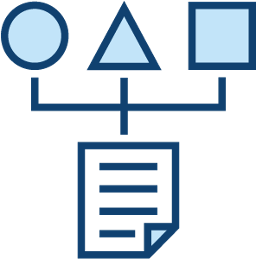We deliver data analytics expertise with Qlik to your classroom
Data analysis competence encompasses more than mere tool know-how. You decide which employees should acquire which competences. We deliver them free to your training room. With our modular course concept, we pick up your employees precisely where they need to be, so they are neither over- nor under-challenged.
Get an overview of our standardised, competence-oriented trainings below - if required, we can customise them to your needs.

Challenge:
Data is rarely available in a form that can be analysed immediately: For example, you have to load data from different source systems (e.g. accounting, ERP, CRM, Excel with budget values) in a common analysis. In Excel you carry out several manual steps, in the best case you create a macro for partial automation.
In BI systems, this process is automated: This is known as the ETL process (Extract Transform Load) or data modelling.
Expertise:
Data modelling is the practical application of set theory. This sounds more mathematical than it is. Data modelling requires above all "analytical thinking".
In theory, this means: Analytical skills capture the ability to mentally or physically break down a complex system into its elements or subsystems, to classify them, and to uncover causal and final relationships between them.
In practice, this means: you load tables, create intersections with other tables, process the result into a continuation table, which you finally pivot as in Excel.
In addition to analytical skills, specialist database know-how, especially SQL, is very helpful.
Our trainings for you:
This course is tool-independent and shows you the necessity of data modelling with practical examples. You realise that certain management questions cannot be answered with existing data sets: You need to transform the data to be able to answer the questions.
Aim of the course:
You learn the practical application of set theory: your way of thinking changes from transactional (case-based) thinking to structured thinking in sets and subsets. This is the basis for analytical thinking: It is not possible to learn analytical thinking in a course. It is possible, however, to sensitise you in this respect. That is the aim of this course.
Target group:
This course is aimed at all future data modellers for whom the term "star schema" is not as natural as daily morning hygiene. We recommend the course for non-modellers as well: whenever you are involved in data analysis, it is helpful to have a basic understanding of thinking in quantities.
Prior knowledge:
none
Duration:
4 hours
This course offers the technical implementation of the course "Introduction to Data Modelling" using SQL (Structured Query Language) . The course takes place in our MSSQL training environment. However, the course is database-independent as the focus is on SQL basics.
Aim of the course:
You will learn the basic functionalities for data retrieval with SQL (JOINS, UNIONs, GROUP BY, etc.) . Manipulation (creating, updating and deleting) of data is "out of scope". The course serves as preparation for the Qlik data modelling courses.
Target group:
We recommend this course for all those people who will be modelling data using Qlik in the future (follow-up courses "Fundamentals of Data Modelling with Qlik" and "Advanced Data Modelling with Qlik") and have no prior knowledge of SQL.
Prior knowledge:
General basic understanding of data analysis and modelling (course "Introduction to Data Modelling")
Duration:
8 hours
In this course you will learn the basics of data modelling with QlikView or Qlik Sense. After loading data from different data sources into a common data model on the first day, you will dive into the world of data transformation on the second day: For example, you will convert annual budget values maintained in Excel aliquot to months in order to be able to perform a target/actual comparison per month.
Aim of the course:
After completing this course you will have a solid toolkit to develop your first Qlik data models. You will understand the importance of the so-called "star schema" and also be able to transform data in this regard.
Target group:
Future Qlik data modellers
Prior knowledge:
General basic understanding of data analysis and modelling (course "Introduction to Data Modelling"), basic SQL knowledge, i.e. the difference between JOIN and UNION should be known (course "SQL Basics").
Duration:
16 hours
In this practical workshop, you will experience the typical challenges in dealing with hierarchies (e.g. cost centre hierarchies).
Aim of the course:
You will learn both methodological approaches to dealing with hierarchies and the technical solutions using QlikView or Qlik Sense.
Target group:
Experienced Qlik data modellers who have data modelling challenges within your organisation dealing with hierarchies.
Prior knowledge:
Practical experience in data modelling with Qlik
Duration:
8 hours
Imagine the following scenario: As a production planner for a plant manufacturer, you create Gantt project plans with start and end times for each operation. Now you are supposed to evaluate the capacity utilisation per day - so you have to divide the operations into daily "slices" (time slices).
This practical workshop shows you the typical difficulties and approaches to solutions when dealing with time series.
Aim of the course:
You will learn methodological approaches as well as the technical implementation using QlikView or Qlik Sense in dealing with time series.
Target group:
Experienced Qlik data modellers facing concrete challenges in dealing with time series.
Prior knowledge:
Practical experience in data modelling with Qlik
Duration:
8 hours
Qlik data models are often historically grown data models: started small, they grow over time into true "juggernauts" - at the expense of performance (script runtime and/or RAM). In this workshop you will optimise such a "juggernaut" in terms of both script runtime and RAM requirements.
Aim of the course:
In this practical workshop, you will learn the factors that influence the performance of Qlik data models so that you can make them perform better with simple tips and tricks.
Target group:
Experienced Qlik data modellers with concrete challenges regarding script runtimes or RAM consumption of data models.
Prior knowledge:
Practical experience in data modelling with Qlik
Duration:
8 hours

Challenge:
Data analysis tools, whether Excel or BI tools, provide almost endless possibilities for presenting information. The palette ranges from bar charts and line charts to pie charts and "exotics" such as spider charts or Marimekko diagrams.
However, data visualisation is ultimately about preparing decision-making bases for managers. The manager must be able to quickly find his way around and derive the messages that are relevant for decision-making. Therefore, the following almost always applies: less is more. Uniform chart types and e.g. colours for actual and planned values help decision-makers to find the essentials more quickly.
Expertise:
While in data modelling we often speak of the so-called developer role, in visualisation we speak of the designer role. In web-based data analysis, the role is often understood as "web designer": This is consistent with the "classic role of a web designer, as long as it is about navigating through an analysis application. The web designer guides the visitor through the website, the data analysis designer through the analysis application - e.g. from the management dashboard with a sales key figure to the sales dashboard and from there to a detailed analysis with all sales orders.
Good data visualisation, however, requires two other core competencies in addition to design competence:
1. Management competence: The aim of data visualisation is to prepare the basis for decision-making for decision-makers - usually managers. The person preparing the data must therefore be able to think like a decision-maker. Only then can they visualise the information accordingly.
2. Assuming perspective: the person preparing the data must be able to think in terms of other people and roles. On the one hand, this applies to the organisation, e.g. top management has different analysis requirements than middle management (e.g. dashboard vs. data discovery). On the other hand, it also applies to one's own personality: the person preparing the data must literally "get out of one's own skin" - otherwise a number-driven spreadsheet person will supply the whole company exclusively with spreadsheets.
Our trainings for you:
This course is tool-independent and introduces you to the world of data visualisation. First, you will delineate terms such as reporting, dashboarding, data discovery, self-service BI, etc. and review them for application scenarios.
After this introduction, learn the best practices of information visualisation. Starting with negative examples, you will see step by step how the negative example is transformed into a best practice example and the same data suddenly becomes the basis for decision-making!
Aim of the course:
You will first learn typical application scenarios of information visualisation from reports to self-service dashboards - with all the advantages and disadvantages. Then you will deepen your know-how in the visualisation of information with the help of tables and charts and learn the "don't do's" as well as the "best practices".
This course provides the necessary knowledge for visualising information. The technical implementation with the help of tools is not part of this course.
Target group:
This course is aimed at all future "designers" (report or dashboard developers) who not only want to copy existing analyses or pre-specified evaluations 1:1, but also want to actively contribute to improving the visualisation of information.
Previous knowledge:
none
Duration:
8 hours
In this course you will learn the basics of data visualisation with QlikView or Qlik Sense. Step by step you will develop an analysis application. The focus is on visualisation best practices and not on the product. In concrete terms, this means that while you learn about all the chart types supported by the product in a product training, you focus on the "common" ones in this training. For example, you standardise colours for actual, historical and planned values.
Aim of the course:
After completing this course, you will be able to build your own analysis applications with QlikView or Qlik Sense. You will learn the best practices of visualisation with Qlik on the one hand and the basics of formula design in Qlik on the other hand. For example, depending on the period selection, you will be able to show the current turnover as well as the turnover in the comparable period of the previous year.
Target group:
This course is aimed at all future QlikView or Qlik Sense designers.
Previous knowledge:
General basic understanding of data visualisation (course "Fundamentals and Best Practices of Data Visualisation")
Duration:
16 hours
From a technical point of view, the visualisation of information consists of 2 components: first of all the calculation and then the actual visualisation. The calculation is not always so trivial that simply a sum or an average value is formed over a dimension (e.g. customer). Once you are asked to measure the agent turnover against a benchmark value - e.g. all agents in the same country. Another time you want to select two agents and compare them against each other. All this is child's play in QlikView and Qlik Sense - if you know how to do it ...
Aim of the course:
After completing this course, you will be able to create and understand complex formulas in QlikView or Qlik Sense. You will first develop an in-depth understanding of set analysis before moving on to complex aggregations (e.g. weighted vs. non-weighted average). In this context, you will learn, for example, about the functions and differences between total and aggr(). Finally, you will deal with statistical functions.
This course is particularly convincing due to its practical relevance: All examples are taken from the daily Qlik project business.
Target group:
This course is aimed at Qlik designers with initial Qlik experience who want to expand their Qlik know-how in the topics of "Set Analysis", aggregation and statistical functions.
Previous knowledge:
First experience as a Qlik designer (course "Visualisation with Qlik")
Duration:
8 hours

Challenge:
Data analysis should create the basis for decisions: The visualised data must be interpreted: The drastic change in a key figure may have operational reasons or may simply be due to data quality. Both causes require measures: but in each case completely different!
Expertise:
Data analysis is about the use of analysis applications. These are intended to help in decision-making, but the decision is still made by the decision-maker: the ability to understand complex interrelationships and the associated problem-solving skills are therefore required.
Our trainings for you:
In this tool-independent course, we show you the typical mistakes in data analysis: from practice for practice, as we experience them in our daily project business. An analysis application can be as great as it is, if in the end the wrong conclusions are drawn.
Aim of the course:
The course sensitises you to possible misinterpretations of data using several examples from daily project practice.
Target group:
Anyone who analyses data in any way (whether with Excel or as a user of a BI dashboard).
Prior knowledge:
none
Duration:
4 hours
In this course you will learn how to use analysis applications with QlikView or Qlik Sense. You will first get to know the central principle of associative data analysis in Qlik before you deal with the "handling" of applications - e.g. filtering data, locking filters, setting bookmarks and much more.
Aim of the course:
The course shows you how to use QlikView or Qlik Sense analytics applications. It covers the general, cross-application standard functionalities. Application-specific training (e.g. navigation within a specific app) and special features (e.g. special logics) are not part of this course.
Target group:
End users of QlikView or Qlik Sense applications
Prior knowledge:
none
Duration:
2 hours
Have we aroused your interest?
Discuss your training needs via video conference (Google Meets or Microsoft Teams) in a free initial meeting with Reinhold Luschnitz